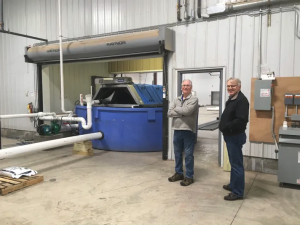Originally posted by TheFishSite.com

Devonian Capital focuses on investing in – and advising on – the establishment and operation of land-based aquaculture projects with a strong technology component. The five-strong team contains an international mixture of people with hands-on aquaculture, investment, sales and entrepreneurial experience.
Co-founder, Jamie Stein, speaks to The Fish Site about why it’s a good time to invest in RAS, despite so many land-based ventures failing in the past, and what challenges still need to be overcome.
What land-based ventures has Devonian Capital invested in to date?
We’ve invested into two early-stage businesses, both in the USA. These are Finger Lakes Fish (better known as LocalCoho), which is growing coho salmon in Upstate New York, and Waterfield Farms, which is focused on growing tilapia, giant river prawns (Macrobrachium rosenbergii) and organic produce.
What drew you to invest in aquaculture?
We feel that there is a huge opportunity for land-based and/or controlled-environment fish farming driven by significant macro-economic factors. The supply-and-demand dynamics of seafood over the last number of decades are well understood. What is less understood is that when demand outstrips supply the impact is not only on the price of the fish, it is also on the value of the quota (whether that is a wild-capture quota or a farming quota). As the value of licences rise, the relative cost of RAS as a production system declines, making these projects more feasible. At the same time, there are now a number of RAS systems out there that are proven to work well, and which can make an economic return for the farmer.
We are at a fascinating point where a number of cost and experience curves are intersecting, but that does not mean that all projects will succeed. Many will not, for a number of reasons. We set ourselves up with the mission of catalysing investment into this emerging field of land-based aquaculture, and for us that means identifying the projects which we believe will succeed; investing ourselves; and then bringing in other investors alongside us.
What made LocalCoho and Waterfield stand out, from an investment perspective?
In each case we were impressed by the experience of the team, by their assessment of the market opportunity for the species they were growing and by the choice of technology that they had made. We felt that the financials stood up to scrutiny, and we felt that the valuation and terms we were offered were appropriate for the early-stage risk we were being asked to take.
Are all your investments in RAS, or do you invest in a range of land-based production methods?
We have a strong preference for RAS. However, we might consider other land-based systems in certain situations, especially where the volumes of water required are very low (for example hatcheries).
Why have so many RAS projects failed over the last decade?
Projects fail for a variety of reasons. Sometimes they are producing a fish for which there is no local market. Sometimes the senior team is over-optimistic in terms of what the business will achieve and/or when, and don’t capitalise the business adequately. Sometimes the technology is not appropriate for the species or the water. Sometimes operational management is the gap. In order for an operation to succeed many factors need to be working in its favour. It starts with the market, of course, but team structuring, technology selection and project finance are also important considerations.
Apart from finance, what do you contribute to the projects that you invest in?
We are able to provide technical and management inputs, based on [co-founder] André Bravo’s extensive experience of managing fish farming operations and companies, including RAS, ponds and cage farms. These inputs can range from identifying good RAS engineers to discussing operational and commercial matters and strategies. We are able to provide inputs relating to the raising of capital. And we are able to provide opinions on the various aspects of managing a complex, early-stage business. We see ourselves as a very supportive shareholder, and we would hope that our investee companies agree!
What have been the most interesting developments in the land-based aquaculture sector since you’ve been involved?
The buy-in by large salmon companies – significantly increasing the scale of their post-smolt farms – and by a range of investors, from private to institutional. And of course, Atlantic Sapphire’s massive project in Miami, which has captured the industry’s attention – we’re all anxious to see the numbers coming out the door into the market, aligned with the company’s projections.
What are the major challenges that land-based projects need to overcome?
In order to produce high volumes of fish at prices that consumers can afford, the cost of project construction needs to come down (which we are starting to see some evidence of, although not across the board). It really matters how much capital you need per tonne of production! The cost of that capital also needs to come down (which will require promoters and engineers to be very transparent about what works and doesn’t work – and why). Feeds, which have been typically developed for cage farms, need to be adapted to RAS farms. Finally there needs to be more hands-on operational experience – good people learning how to solve the normal day-to-day challenges in well designed, located and run facilities. All these things will happen in time, but they are probably the main challenges to overcome.
Why do you think the investment community has started to take an interest in aquaculture in recent years?
I think that there has been an increased interest from institutional investors in agriculture generally and agricultural commodities over the last 15 years or so, and I think that the interest in aquaculture is a natural extension of that. One of the attractions for investors is that a reasonable amount of production can be built out for tens of millions of dollars rather than hundreds of millions of dollars. At the same time, this can keep some investors away, who don’t want to deploy into a space until it can absorb significantly larger amounts of capital. So there is an issue there that investors and projects will need to work together on.
How do you see the land-based sector evolving over the next decade?
We think that the sector will grow, led by a small number of “exemplar” projects, like LocalCoho and Waterfield Farms, which are able to demonstrate solid returns on invested equity, as well as “walking the walk” from a sustainability and traceability perspective.
Is your name geographically or geologically inspired?
We’re not based in Devon – the name refers to the era when fish first came onto the land, and we’re trying to bring fish farming onto the land…
Would you consider investing in other areas of aquaculture?
Not at the moment!



